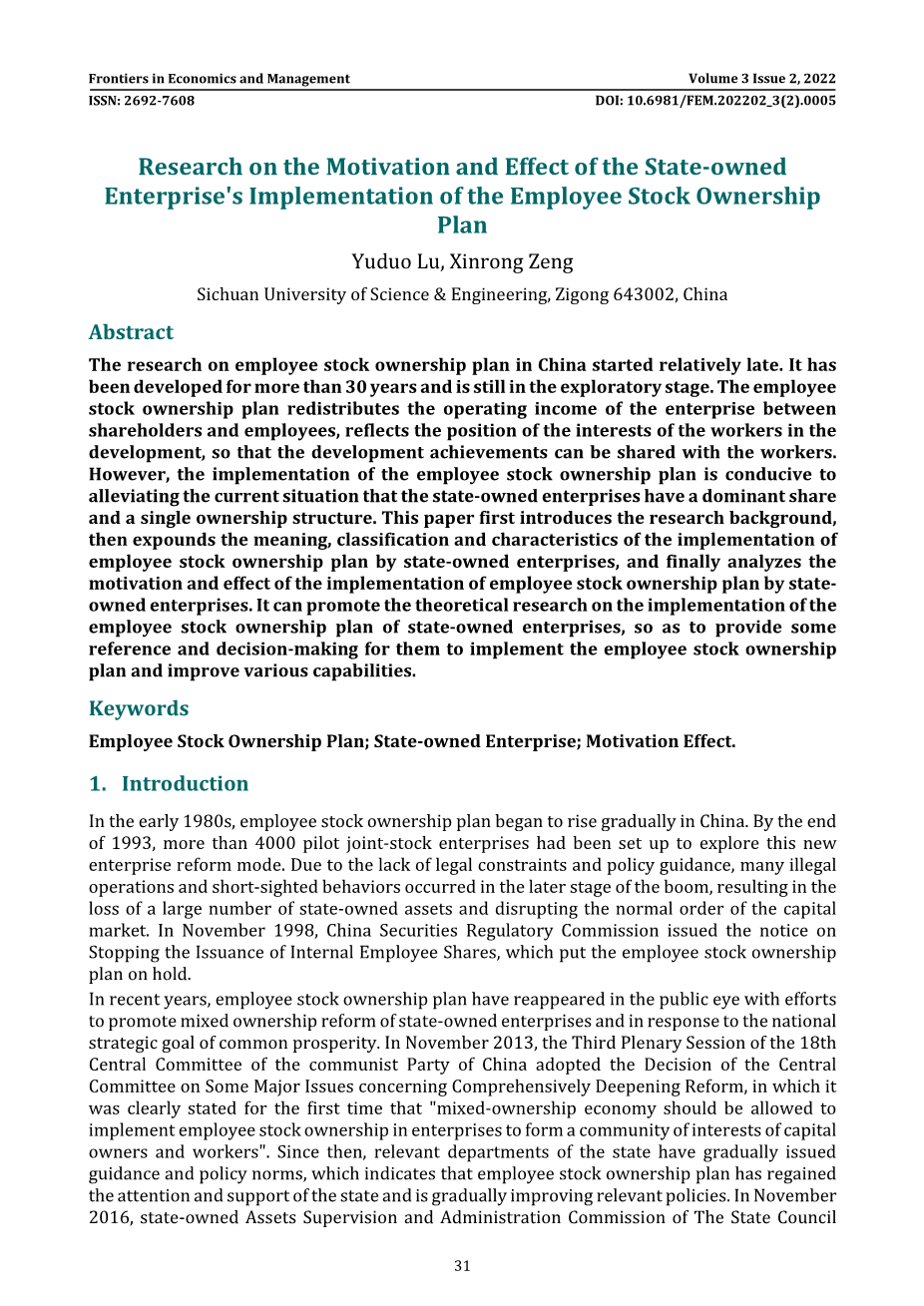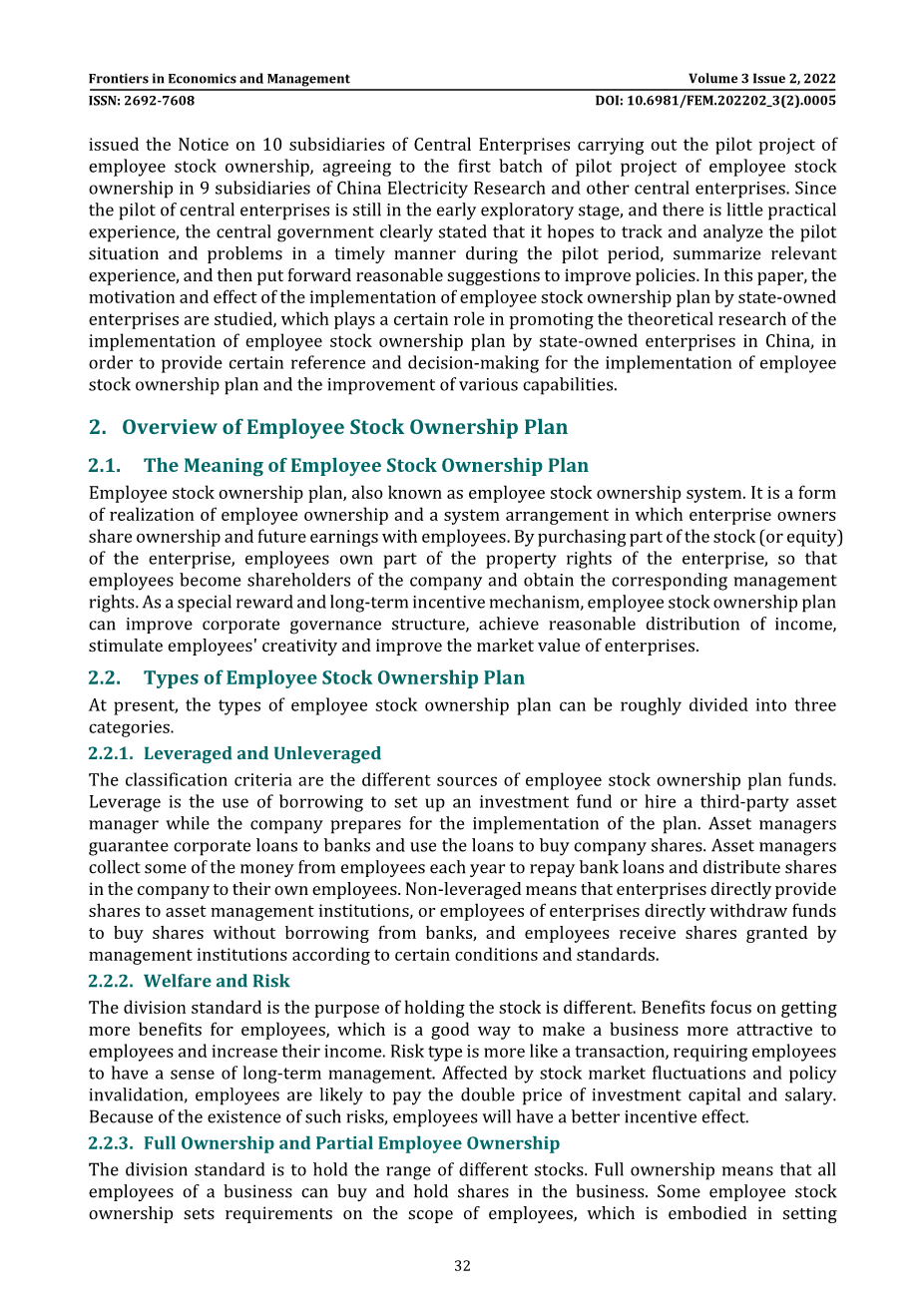

英语原文共 7 页,剩余内容已隐藏,支付完成后下载完整资料
Research on the Motivation and Effect of the State-owned Enterprises Implementation of the Employee Stock Ownership Plan
Yuduo Lu, Xinrong Zeng
Sichuan University of Science amp; Engineering, Zigong 643002, China
ABSTRACT
The research on employee stock ownership plan in China started relatively late. It has been developed for more than 30 years and is still in the exploratory stage. The employee stock ownership plan redistributes the operating income of the enterprise between shareholders and employees, reflects the position of the interests of the workers in the development, so that the development achievements can be shared with the workers. However, the implementation of the employee stock ownership plan is conducive to alleviating the current situation that the state-owned enterprises have a dominant share and a single ownership structure. This paper first introduces the research background, then expounds the meaning, classification and characteristics of the implementation of employee stock ownership plan by state-owned enterprises, and finally analyzes the motivation and effect of the implementation of employee stock ownership plan by stateowned enterprises. It can promote the theoretical research on the implementation of the employee stock ownership plan of state-owned enterprises, so as to provide some reference and decision-making for them to implement the employee stock ownership plan and improve various capabilities.
KEYWORDS
Employee Stock Ownership Plan; State-owned Enterprise; Motivation Effect.
- Introduction
In the early 1980s, employee stock ownership plan began to rise gradually in China. By the end of 1993, more than 4000 pilot joint-stock enterprises had been set up to explore this new enterprise reform mode. Due to the lack of legal constraints and policy guidance, many illegal operations and short-sighted behaviors occurred in the later stage of the boom, resulting in the loss of a large number of state-owned assets and disrupting the normal order of the capital market. In November 1998, China Securities Regulatory Commission issued the notice on Stopping the Issuance of Internal Employee Shares, which put the employee stock ownership plan on hold. In recent years, employee stock ownership plan have reappeared in the public eye with efforts to promote mixed ownership reform of state-owned enterprises and in response to the national strategic goal of common prosperity. In November 2013, the Third Plenary Session of the 18th Central Committee of the communist Party of China adopted the Decision of the Central Committee on Some Major Issues concerning Comprehensively Deepening Reform, in which it was clearly stated for the first time that 'mixed-ownership economy should be allowed to implement employee stock ownership in enterprises to form a community of interests of capital owners and workers'. Since then, relevant departments of the state have gradually issued guidance and policy norms, which indicates that employee stock ownership plan has regained the attention and support of the state and is gradually improving relevant policies. In November 2016, state-owned Assets Supervision and Administration Commission of The State Council issued the Notice on 10 subsidiaries of Central Enterprises carrying out the pilot project of employee stock ownership, agreeing to the first batch of pilot project of employee stock ownership in 9 subsidiaries of China Electricity Research and other central enterprises. Since the pilot of central enterprises is still in the early exploratory stage, and there is little practical experience, the central government clearly stated that it hopes to track and analyze the pilot situation and problems in a timely manner during the pilot period, summarize relevant experience, and then put forward reasonable suggestions to improve policies. In this paper, the motivation and effect of the implementation of employee stock ownership plan by state-owned enterprises are studied, which plays a certain role in promoting the theoretical research of the implementation of employee stock ownership plan by state-owned enterprises in China, in order to provide certain reference and decision-making for the implementation of employee stock ownership plan and the improvement of various capabilities.
-
Overview of Employee Stock Ownership Plan
- The Meaning of Employee Stock Ownership Plan
Employee stock ownership plan, also known as employee stock ownership system. It is a form of realization of employee ownership and a system arrangement in which enterprise owners share ownership and future earnings with employees. By purchasing part of the stock (or equity) of the enterprise, employees own part of the property rights of the enterprise, so that employees become shareholders of the company and obtain the corresponding management rights. As a special reward and long-term incentive mechanism, employee stock ownership plan can improve corporate governance structure, achieve reasonable distribution of income, stimulate employees creativity and improve the market value of enterprises.
-
- Types of Employee Stock Ownership Plan
At present, the types of employee stock ownership plan can be roughly divided into three categories.
-
-
- Leveraged and Unleveraged
-
The classification criteria are the different sources of employee stock ownership plan funds. Leverage is the use of borrowing to set up an investment fund or hire a third-party asset manager while the company prepares for the implementation of the plan. Asset managers guarantee corporate loans to banks and use the loans to buy company shares. Asset managers collect some of the money from employees each year to repay bank loans and distribute shares in the company to their own employees. Non-leveraged means that enterprises dir
剩余内容已隐藏,支付完成后下载完整资料
资料编号:[589576],资料为PDF文档或Word文档,PDF文档可免费转换为Word
以上是毕业论文外文翻译,课题毕业论文、任务书、文献综述、开题报告、程序设计、图纸设计等资料可联系客服协助查找。
您可能感兴趣的文章
- 薪酬满意度作为工作满意度的先行因素:建立一个回归模型,确定公共和私人组织中薪酬满意度与工作满意度之间的线性关系外文翻译资料
- 胜任力与胜任力、胜任力模型与胜任力模型的比较研究外文翻译资料
- 如何提高企业网络招聘的有效性外文翻译资料
- 为初级职位招聘大学生,在制定战略和战术校园招聘计划时,需要考虑哪些问题?外文翻译资料
- 基于能力的招聘:招聘和留住成功员工的关键外文翻译资料
- 员工培训对体育门票销售人员工作满意度的影响外文翻译资料
- 由雇主参与的创新型员工激励模式外文翻译资料
- 浅析企业文化与企业绩效的相关性 ——以苏州金色未来信息咨询股份有限公司为例外文翻译资料
- 互联网背景下基于平衡计分卡的计算机绩效评价系统外文翻译资料
- 提高斯洛伐克公共行政部门招聘过程的效率外文翻译资料


